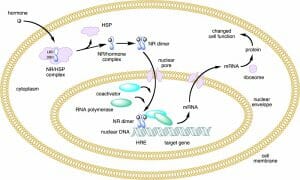Cytosol Definition
Cytosol is the liquid found inside of cells. It is the water-based solution in which organelles, proteins, and other cell structures float.
The cytosol of any cell is a complex solution, whose properties allow the functions of life to take place. Cytosol contains proteins, amino acids, mRNA, ribosomes, sugars, ions, messenger molecules, and more!
Though once thought to be a simple solution, scientists are increasingly discovered that cytosol can have structure and organization. For example, some cells use gradients of ions or messenger particles to contain important information that is necessary for later growth.
Some species use organization of their cytoplasm to direct the growth of embryos from the fertilized egg cell. In these species, messenger molecules are distributed differently throughout the cytoplasm of the egg cell. When the egg cell divides after fertilization, this results in different daughter cells receiving different messenger molecules – and subsequently developing into different tissue types.
This principle shows the importance and complexity of the cytoplasm, which was once thought to be mere salt water!
Membrane-bound organelles float in the cytosol, but their interiors are not considered to be part of it. Chloroplasts, mitochondria, nuclei, and other closed, self-contained membranes within cells have their own internal fluid and chemistry that is separate from the cytosol.
Function of Cytosol
Cytosol serves as the medium for intracellular processes. This means it must be contain the proper proteins, ions, and other ingredients for cytosolic activities.
Activities that take place in, or involve the cytosol include:
1. Enzyme activities. Enzymes often require certain salt concentrations, pH levels, and other environmental conditions to work properly.
2. Signal transduction. Messenger molecules may diffuse through the cytosol to change the functioning of enzymes, organelles, or even DNA transcription. These may be messengers from outside the cell, or messengers from one part of the cell to another.
The diagram below shows an example of how signaling molecules can move through the cytosol to effect the functions of proteins and even the cell’s nucleus.
3. Structural support of the cell and organelles. Most cells rely on the volume of cytosol to create its shape and create space for chemicals to move within the cell.
4. In prokaryotes which lack membrane-bound organelles, virtually all functions of life including DNA transcription and replication, glycolysis, etc., happen in the cytosol.
Related Biology Terms
- Cell – The basic unit of life, which makes up all organisms.
- Cytoplasm – The total contents of the cell. This includes both cytosol – the fluid outside of the organelles – and the organelles themselves.
- Extracellular fluid – The fluid outside of a cell. A major function of the cell membrane is to separate the extracellular fluid from the cytosol, and ensure the proper composition of the cytosol.
Quiz
1. Which of the following is NOT part of the cytosol?
A. The fluid between the cell membrane and the organelles
B. The mitochondria
C. The nucleus
D. B and C
2. Which of the following does NOT occur in the cytosol?
A. Enzyme activity
B. Cell signal transduction
C. Cellular respiration
D. All of the above
3. Which of the following is NOT an important characteristic of the cytosol?
A. It must maintain the proper ion balance to allow enzymes to function.
B. It must maintain the proper volume to give shape to the cell.
C. In some circumstances, it must maintain a gradient of signaling molecules so that different signals will be inherited by each daughter cell.
D. None of the above.
Cytosol
No comments:
Post a Comment